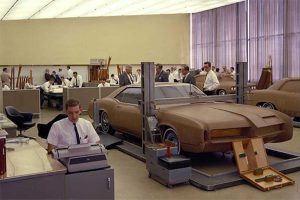The 1966 Oldsmobile Toronado was a radical departure and a testament to the brand’s long-time technical excellence at the time. Here’s a look back at what became the first front-wheel-drive car from a U.S. automaker in decades.
With the troubles that have beset General Motors in recent decades, its fall from the rank as world’s largest automaker into the depths of Chapter 11 Bankruptcy, it’s easy to forget what an engineering powerhouse the company had become by the 1960s. It’s a time when accountants hadn’t yet penny-pinched the company into irrelevance, when design and engineering remained among the best of the world.
As if to prove it, GM’s Oldsmobile Division revealed something radically new this week 59 years ago: the first front-wheel-drive car from an American manufacturer since the 1937 Cord 810 and 812: the Oldsmobile Toronado.
It might be easy to forget what an achievement the Toronado was both in design and engineering, earning Motor Trend’s prestigious 1966 Car of the Year award, Car Life’s Award for Engineering Excellence and placed third in the European Car of the Year competition. Yet such superiority didn’t come overnight. In fact, the new Toronado took a decade to reach fruition.
AN EXPERIMENTAL POWERTRAIN
The Toronado’s development initiated at the 1955 GM Motorama at the Waldorf-Astoria in New York City, where General Motors began to investigate producing a front-wheel drive automobile. To gauge public opinion, the company displayed the LaSalle II, sporting a dual-overhead camshaft V6 engine, and the L’Universelle van, which was powered by a production Pontiac V8. Both cars featured the automaker’s experimental front-wheel-drive “Unitized Power Package,” or UPP. This driveline combined a V-engine setup with a whole differential and axle assembly into a single power pack that took up no more space than an engine of the same displacement on its own.
Under assistant chief engineer John Beltz, Oldsmobile carried out further development of the UPP in 1958. The end product was the F-85, a front-wheel-drive concept car with a V-6 engine positioned transversely and linked to an automatic four-speed gearbox. But the UPP remained an experimental driveline.
Yet the changing auto market of the 1960s brought about new product opportunities.
The most pressing was the fielding a competitor to the Ford Thunderbird, which had gained a back seat in 1958 and instantly created a new market: the personal luxury coupe. In its effort to challenge Ford’s high-flying bird, Oldsmobile looked to developing its UPP as part of the new car’s design. Before long, GM gave the thumbs-up for the new car’s development.
A NEW CAR TAKES SHAPE
The car’s design has to showcase its state-of-the-art engineering. David North, the car’s designer, did include a few stylistic elements from the 1937 Cord 810/812, most notable its hidden headlights and horizontal grille, integrating them into a contemporary, innovative design.
“I believe you see a little bit of the Cord in the grille,” North told Special Interest Autos in 1971. But “the car we were doing had to have sheer sides instead of pontoon fenders, but we did wrap the grille as it went across the car-wrapped it back into the engine compartment. This was a direct influence from the Cord.”
Originally designed on the mid-sized A-Body platform as a “four-person Corvette”, adopting the platform for the UPP didn’t pencil. So GM brass dictated that the Toronado use GM’s larger E-Body architecture, which was being used for the 1966 Buick Riviera and 1967 Cadillac Eldorado, to save on costs.
Power came from Oldsmobile’s 7.0-liter V-8 engine boasted a Rochester 4-barrel Quadrajet carburetor and was good for 385 horsepower and 475 pound-feet of torque. But unlike contemporary front-wheel drive cars, which position engines in an East-West configuration, the Toronado’s V-8 was placed North-South.
A SPECIAL LOOK
But unique design was evident throughout the car.
“This was going to be a modern car. It was going to be an American expression, an original, and we weren’t out to copy anybody,” added Stan Wilen, chief designer at the Oldsmobile Studio.
Oldsmobile’s UPP eliminated the center driveline hump that afflicted nearly all cars of the time, endowing the car with a generous amount of legroom. Its instrument cluster featured a unique drum speedometer that rotated as the car’s speed increased.
It proved successful, selling nearly 41,000 units for 1966, its unique shape remaining mostly unchanged through 1971. The 1971 redesign would prove far less distinctive, and the Toronado would never again boast a look as daring or original as it did upon its debut. It would remain in production through 1992.









0 Comments